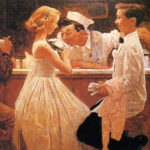A comedian did a bit a few years ago about how everything is amazing, but we’re always angry. We’re flying on a jet that takes us from New York City to Los Angeles in a few hours—amazing!—and we’re able to chat with people anywhere in the world while we do it—amazing!—and then we’re told we have to shut off our cell phones for a few minutes, and we explode in anger, as though we had some kind of God-given right to do these amazing things, and their momentary absence represents an injustice.
One way to describe this phenomenon is as a form of possessiveness. Possessiveness implies a deep insensibility to the amazingness of the world. Our familiar possessions—the things that we lay claim to by right, as ours—become difficult to see with fresh attention, or with gratitude. J. R. R. Tolkien says that the things around us “have become like the things which once attracted us by their glitter, or their colour, or their shape, and we laid hands upon them, and then locked them in our hoard, acquired them, and acquiring them ceased to look at them.” This is a pitiable state of affairs. But all is not lost. We can recover these things, in their amazingness. One way to do so is through the phenomenon of mooreeffoc:
Mooreeffoc is a fantastic word, but it could be seen written up in every town in this land. It is Coffee-room, viewed from the inside through a glass door, as it was seen by Dickens on a dark London day; and it was used by Chesterton to denote the queerness of things that have become trite, when they are seen suddenly from a new angle.
Tolkien’s idea here is that the possessiveness and insensibility we so easily fall into can be broken through, at least temporarily, by seeing those things we take for granted in a new way: metaphorically (or even literally) from a new angle. I think Norman Rockwell intuitively deploys this strategy in his art. His famed realism and attention to detail take that which is commonplace, and make it once again both startling and delightful. He aims to make us see the world that is really here, but that we so often take no notice of, precisely because it’s so familiar to us that we don’t bother to see it.
Start your day with Public Discourse
Sign up and get our daily essays sent straight to your inbox.Making the Familiar Unfamiliar
Sometimes all it takes is a minor change in one’s point of view, to make the familiar seem unfamiliar—and to make one grateful for it again. Every parent has no doubt introduced a child to some beloved place or activity: in helping to point out the wonders of the new thing to the child, the parent stops and notices them again, perhaps for the first time in a long time. And in so doing, he becomes freshly appreciative. When Rockwell selects a simple scene and comically renders it in loving detail, he proposes it to you for fresh appreciation.
Even a minor work such as his “Coin Toss” can become a delightful way to take a new look at things. It shows two kids on the football field, watching the ref’s coin toss to decide first possession. These kids are not stereotypical football players—they’re skinny and maybe a bit uncoordinated. But they are all business. This picture exemplifies the great Chestertonian line that if a thing is worth doing, it’s worth doing badly. Despite the caricatures, the whole thrust of this picture is to emphasize the dignity of the players, not to mock them. The scene is being enacted with utter seriousness, from the fans intently watching on the sidelines, to the impeccably uniformed referee, to the grave faces of the players. This may not be a highly skilled football game, but it will be conducted with all due propriety.
When Rockwell selects a simple scene and comically renders it in loving detail, he proposes it to you for fresh appreciation.
Taking it seriously is part of the fun of it. And they are taking it seriously for what it really is—just a game. In making this picture, Rockwell was holding up for our appreciation the rituals of youth. He’s selected a thing his viewers might have seen a thousand times—the beginning of a youth sporting event. And he’s presented it to them so that they can try to see it for the first time. The apparent inappropriateness of the kids to the task is the new angle that makes us look again. “Ha!” we think, “those kids ain’t real football players!” But they are. More real than the ones you see on TV playing the game for millions of dollars. They’re more real because they do it for love of the game.
Take another case of something worth doing badly: love. This is a commonplace, for sure. Young man and young woman meet, fall in love, marry, etc. Nothing could be more familiar. In fact, once you’ve been married a couple of decades, it can become all too easy to forget entirely just how exciting all that really is. Imagine someone who spends his days handing out marriage licenses to eager young couples. Such a person would be at even greater risk than usual for forgetting—for taking for granted. Rockwell captured this in one of his more famous pictures.
A young couple have come on a Saturday, all dressed up, to collect their marriage license. Rockwell has refrained from caricature here. But he has added the cute touch of having the young woman, already in high heels, standing on her tiptoes to be able to properly get at the form. The office is shabby, with deteriorating wallpaper and cigarette butts scattered everywhere. The clerk isn’t hostile, but he’s wholly indifferent. The office is dark, except for the window and the glowing golden dress. But even the window is, visually, walled up. I think the clerk is a warning. His indifference is incongruous. It doesn’t belong. His long exposure to these eager young couples has make the process trite to him. But it’s not trite: he’s not seeing it correctly. Am I the indifferent clerk, or am I the grateful couple? This depiction of a commonplace event helps us to see it as it really is: the most important thing in the world.
Embracing the Commonplace
In his recent piece on Rockwell in this journal, Aaron Walayat did a fine job of defending Rockwell against the charge that he’s a kitsch painter. In general, I want to endorse what Walayat wrote, but I want to offer one criticism. Specifically, Walayat writes,
But for those of us desiring beauty, Rockwell’s work does not go far enough. It is not transcendent, seeking nothing more than the joy in the mundaneness of ordinary life. In the quest for sublimity, Rockwell cannot be the final stop. Perhaps we must learn to outgrow him. But outgrowing Rockwell does not mean we must abandon our appreciation for what his work was able to do. Unlike makers of kitsch, Rockwell is capable of creating art that expresses real sentiment. But Rockwell’s art is not the final stop. His work instead prepares us for more, to experience the sentiments expressed in a work rather than just to be charmed by an unreal, remote, and picturesque world.
It seems to me that we can never outgrow the need for recovery. Precisely because our ordinary lives are so ordinary—commonplace, not mundane, is the Rockwellian (and Dickensian) term—we will likely never escape the risk of possessiveness. And great works like Rockwell’s, through the use of mooreeffoc, can free us from this trap.
No doubt there is great value in the sublime as “above” the commonplace, and Rockwell rarely pursues sublimity. I do not mean to disparage what might be called high art. I mean to assert instead two things. First, not all artists, to be valuable, must pursue high art. As St. Paul put it, “the eye cannot say to the hand: I need not thy help; nor again the head to the feet: I have no need of you. Yea, much more those that seem to be the more feeble members of the body, are more necessary” (1 Cor 12:21–22). Second, if we conceptualize ourselves as seekers of beauty, questers for sublimity—we’re in effect saying that beauty and sublimity are not all already around us. We’re saying let me escape this mundanity and find a higher, greater world. But this is the world God has made—this is the day the Lord has made—and it is good.
Affirming Reality’s Intractable Goodness
Think of one more Rockwell picture: “Freedom From Fear.” Painted in 1943, it shows a mom and dad checking on their two sleeping children. This is a cozy scene, but it was painted during a horrific war. Many of Rockwell’s intended viewers would not have had such happy home lives. Their sons and husbands would have been at war, or perhaps dead already. What is this picture really about? What is he trying to do with it?
Rockwell presents what we were sacrificing for. As Chesterton put it, “The true soldier fights not because he hates what is in front of him, but because he loves what is behind him.” Our boys want to know that things are still good at home. They want to see comforting images of what they’re defending. Our soldiers are fighting so that those little kids can sleep in peace, and so their parents can go about their normal lives without fear. The picture, in that sense, seeks to comfort war-addled Americans not by denying the reality of war, but by depicting the sometimes all-too-hidden reality of home.
This commonplace image shows us that the world is good, and the intrusion of horror and death is just that: an intrusion. Inescapable, yes, but still not the deepest, truest thing.
But we can see more here. The scene is a scene of normality: there are parents and children. Those parents love their children, and those children sleep innocently because of their parents’ care. This is a picture of the goodness of life—the warmth of family, spouses’ love for each other and for their kids. This commonplace image shows us that the world is good, and the intrusion of horror and death is just that: an intrusion. Inescapable, yes, but still not the deepest, truest thing. Rockwell’s pictures are of the deepest, truest thing—the goodness of Creation.
Let me end with Tolkien again (always relevant):
Far above the Ephel Duath in the west the night-sky was still dim and pale. There, peeping among the cloud-wrack above a dark tor high up in the mountains, Sam saw a white star twinkle for a while. The beauty of it smote his heart, as he looked up out of the forsaken land, and hope returned to him. For like a shaft, clear and cold, the thought pierced him that in the end the Shadow was only a small and passing thing: there was light and high beauty forever beyond its reach.
The Shadow is only a small and passing thing. There are light and high beauty forever beyond its reach—and to be found first and last in the commonplaces if anywhere.













